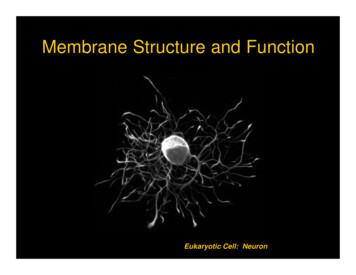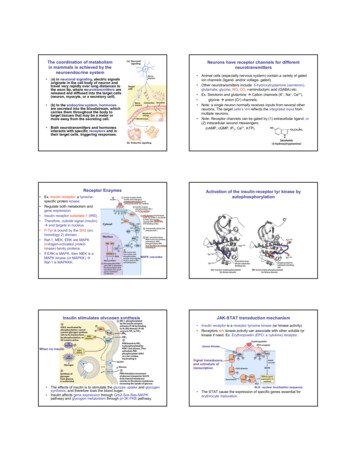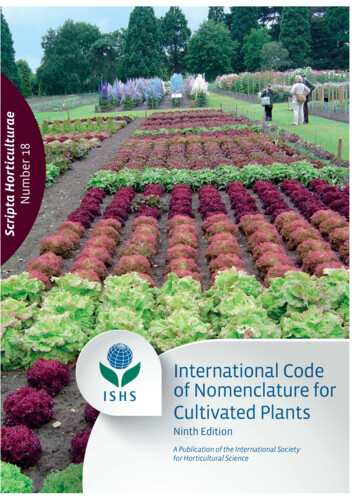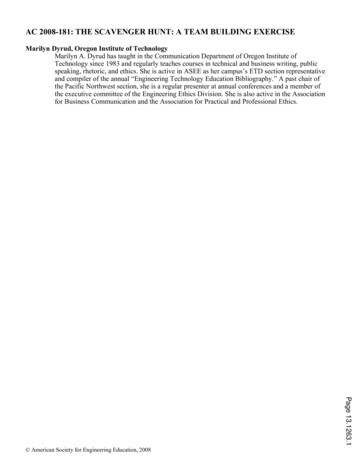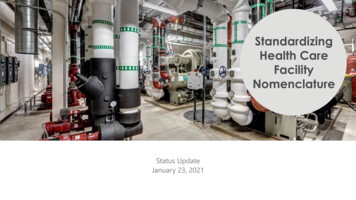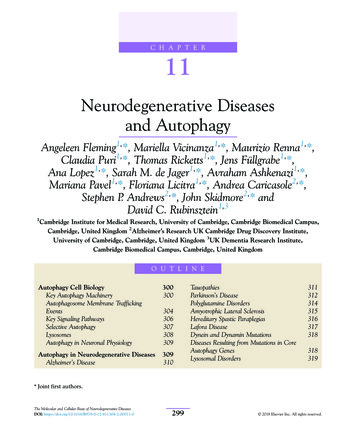
Transcription
Standardizing Scavenger ReceptorNomenclatureThis information is current asof April 20, 2014.Mercy PrabhuDas, Dawn Bowdish, Kurt Drickamer, MariaFebbraio, Joachim Herz, Lester Kobzik, Monty Krieger,John Loike, Terry K. Means, Soren K. Moestrup, StevenPost, Tatsuya Sawamura, Samuel Silverstein, Xiang-YangWang and Joseph El KhouryReferencesSubscriptionsPermissionsEmail AlertsThis article cites 76 articles, 39 of which you can access for free #ref-list-1Information about subscribing to The Journal of Immunology is online at:http://jimmunol.org/subscriptionsSubmit copyright permission requests at:http://www.aai.org/ji/copyright.htmlReceive free email-alerts when new articles cite this article. Sign up at:http://jimmunol.org/cgi/alerts/etocThe Journal of Immunology is published twice each month byThe American Association of Immunologists, Inc.,9650 Rockville Pike, Bethesda, MD 20814-3994.All rights reserved.Print ISSN: 0022-1767 Online ISSN: 1550-6606.Downloaded from http://www.jimmunol.org/ at McMaster Univ Hlth Sci Lib on April 20, 2014J Immunol 2014; 192:1997-2006; ;doi: ntent/192/5/1997
Standardizing Scavenger Receptor NomenclatureMercy PrabhuDas,* Dawn Bowdish,† Kurt Drickamer,‡ Maria Febbraio,xJoachim Herz,{ Lester Kobzik,‖ Monty Krieger,# John Loike,** Terry K. Means,††Soren K. Moestrup,‡‡ Steven Post,xx Tatsuya Sawamura,{{ Samuel Silverstein,‖‖Xiang-Yang Wang,## and Joseph El Khoury***at the workshop and to solicit additional feedbackfrom the broader research community. The Journalof Immunology, 2014, 192: 1997–2006.*Division of Allergy, Immunology and Transplantation, National Institute of Allergyand Infectious Diseases, National Institutes of Health, Bethesda, MD 20892;†Department of Pathology and Molecular Medicine, McMaster Immunology Research Centre, M. G. DeGroote Institute of Infectious Disease Research, McMasterUniversity, Hamilton, Ontario L8S 4K1, Canada; ‡Department of Life Sciences,Imperial College, London SW7 2AZ, United Kingdom; xDepartment of Dentistry,Faculty of Medicine and Dentistry, University of Alberta, Katz Group Centre forPharmacy and Health Research, Edmonton, Alberta T6G 2E1, Canada; {Departments of Molecular Genetics, Neuroscience, and Neurology and Neurotherapeutics,University of Texas Southwestern Medical Center, Dallas, TX 75390; ‖Department ofEnvironmental Health, Harvard School of Public Health, Boston, MA 02115; #Department of Biology, Massachusetts Institute of Technology, Cambridge, MA 02139;**Department of Physiology and Cellular Biophysics, Columbia University, NewYork, NY 10032; ††Center for Immunology and Inflammatory Diseases and Divisionof Rheumatology, Allergy, and Immunology, Massachusetts General Hospital andHarvard Medical School, Charlestown, MA 02129; ‡‡Department of Biomedicine,University of Aarhus, 8000 Aarhus C, Denmark; xxDepartment of Pathology, University of Arkansas for Medical Sciences, Little Rock, AR 72211; {{Department ofVascular Physiology, Research Institute, National Cerebral and Cardiovascular Center, Suita, Osaka 565-8565, Japan; ‖‖Department of Physiology and Cellular Biophysics, Columbia University, New York, NY 10032; ##Department of Human and MolecularGenetics, Institute of Molecular Medicine, Massey Cancer Center, Virginia CommonwealthUniversity School of Medicine, Richmond, VA 23298; and ***Infectious Disease Division,Center for Immunology and Inflammatory Diseases, Massachusetts General Hospital, HarvardMedical School, Charlestown, MA 0003Scavenger receptor activity was first described byDrs. Michael Brown and Joseph Goldstein when theyidentified receptors in macrophages that endocytosedand degraded modified (acetylated), but not native, low-densitylipoprotein (LDL) (1). Drs. Brown and Goldstein showed thatthese acetylated LDL receptors (LDLRs) recognized a widevariety of polyanionic ligands (2). Purification and cloningof the corresponding receptor protein and cDNA (3, 4) wassoon followed by the identification of other modified LDLRswith broad binding specificity. In an initial attempt to systematically categorize these receptors, Dr. Monty Kriegerproposed to subdivide them into “classes” (A, B, and so forth)based on their sequences, and each class was subdivided furtherinto “types” based on additional variations in their sequencesdue to alternative splicing (5).There are currently eight classes of scavenger receptors(classes A–H). In some cases multiple names have been assigned to the same receptor (e.g., MSR1, SR-AI, CD204,SCARA1). Additionally, there are proteins exhibiting scavenger receptor activity that have been named based on othercriteria and have not been included in a general scavenger receptor nomenclature. Some examples include receptor for advanced glycation end products (RAGE), LRP1, LRP2, ASGP,CD163, scavenger receptor that binds phosphatidylserine andoxidized lipids (SR-PSOX), and CXCL16. New scavenger re-Address correspondence and reprint requests to Dr. Mercy PrabhuDas or Dr. Joseph ElKhoury, Division of Allergy, Immunology and Transplantation, National Institute ofAllergy and Infectious Diseases, National Institutes of Health, 6610 Rockledge Drive,Bethesda, MD 20892 (M.P.) or Infectious Disease Division, Center for Immunologyand Inflammatory Diseases, Massachusetts General Hospital, Harvard Medical School,Charlestown, MA 02129 (J.E.K.). E-mail addresses: mprabhudas@niaid.nih.gov (M.P.)and jelkhoury@mgh.harvard.edu (J.E.K.)Abbreviations used in this article: CLEC, C-type lectin; CL-P1, collectin placenta 1; EGF,epidermal growth factor; FEEL, Fasciclin, epidermal growth factor–like and lamin typeepidermal growth factor–like; HDL, high-density lipoprotein; Hgb, hemoglobin; LDL,low-density lipoprotein; LDLR, low-density lipoprotein receptor; LOX-1, lectin-like oxidizedlow-density lipoprotein receptor 1; MARCO, macrophage receptor with collagenous structure;MEGF, multiple epidermal growth factor–like domains; RAGE, receptor for advanced glycation end products; SRCL, scavenger receptor with C-type lectin domain; SRCR, scavengerreceptor cysteine-rich; SREC, scavenger receptor expressed by endothelial cells; SRPSOX, scavenger receptor that binds phosphatidylserine and oxidized lipids.Downloaded from http://www.jimmunol.org/ at McMaster Univ Hlth Sci Lib on April 20, 2014Scavenger receptors constitute a large family of proteinsthat are structurally diverse and participate in a widerange of biological functions. These receptors are expressed predominantly by myeloid cells and recognizea variety of ligands, including endogenous and modifiedhost-derived molecules and microbial pathogens. Thereare currently eight classes of scavenger receptors, manyof which have multiple names, leading to inconsistenciesand confusion in the literature. To address this problem,a workshop was organized by the U.S. National Instituteof Allergy and Infectious Diseases, National Institutesof Health to help develop a clear definition of scavengerreceptors and a standardized nomenclature based on thatdefinition. Fifteen experts in the scavenger receptor fieldattended the workshop and, after extensive discussion,reached a consensus regarding the definition of scavengerreceptors and a proposed scavenger receptor nomenclature. Scavenger receptors were defined as cell surfacereceptors that typically bind multiple ligands and promote the removal of non-self or altered-self targets. Theyoften function by mechanisms that include endocytosis,phagocytosis, adhesion, and signaling that ultimatelylead to the elimination of degraded or harmful substances.Based on this definition, nomenclature and classificationof these receptors into 10 classes were proposed. Thediscussion and nomenclature recommendations describedin this report only refer to mammalian scavenger receptors. The purpose of this article is to describe the proposedmammalian nomenclature and classification developed
1998IMMUNOLOGY NOTES AND RESOURCES: SCAVENGER RECEPTOR NOMENCLATURETable I.Scavenger receptor background and historyThe original description of scavenger receptors was in thecontext of studies of lipoproteins, atherosclerosis, and familialhypercholesterolemia (1, 12). Drs. Michael Brown and JosephGoldstein had previously identified LDLRs and LDLRmediated endocytosis and established that familial hypercholesterolemia was caused by loss of function mutations in theLDLR, which led to increased plasma LDL, premature atherosclerosis, and heart disease. Analysis of familial hypercholesterolemia patients showed that plasma LDL could also bepartially cleared by an LDLR-independent pathway called the“scavenger pathway.” The earliest use of the term “scavengerreceptor” to refer to the broad specificity receptor identified byDrs. Brown and Goldstein was in 1981 by Dr. Alan Fogelmanand colleagues (13).The first scavenger receptors were purified in 1988 (14) andcloned in 1990 (15, 16) by Dr. Monty Krieger’s group. Thesereceptors initially were named type I and type II macrophagescavenger receptors and were found to be alternatively splicedproducts of a single gene. When additional scavenger receptors were identified, the type I and II macrophage receptorswere renamed scavenger receptor, class A, type I and type II(SR-AI and SR-AII) by Dr. Krieger’s group. One distinctfeature of the broad binding specificity of scavenger receptorswas that they could recognize a large repertoire of ligands,ranging from bacteria and yeast to self (native proteins) andmodified-self targets (2, 17–21). Besides playing a role in hostdefense, class A scavenger receptors were shown to be involved in functions such as homeostasis, Ag presentation, andpathogenesis of neurodegenerative disorders (22, 23).Based on their broad ligand-binding specificities and expression in macrophages, Dr. Krieger and colleagues proposedthat scavenger receptors could serve as pattern recognitionreceptors for innate immunity (5). Work done by groupsled by Drs. Siamon Gordon, Tatsuhiko Kodama, and JosephEl Khoury provided direct evidence that the class A receptorsare adhesion receptors, and that they recognize Gram-positivebacteria and b-amyloid, confirming the broad ligand specificityWorkshop participants and their areas of expertiseParticipantAffiliationArea of ExpertiseDawn BowdishKurt DrickamerJoseph El KhouryMcMaster University, Hamilton, ON, CanadaImperial College, London, U.K.Massachusetts General Hospital, Harvard Medical School,Boston, MAUniversity of Alberta, Edmonton, AB, CanadaUniversity of Texas Southwestern Medical Center, Dallas, TXHarvard School of Public Health, Boston, MAMassachusetts Institute of Technology, Cambridge, MAMacrophage scavenger receptors in host defenseC-type lectin and glycan recognitionMacrophage and microglial scavenger receptorsin inflammationCD36 signalingFunctions of LDL receptor-related proteinsMARCO and lung inflammationScavenger receptors in host defense and lipoproteinand lipid metabolismScavenger receptors in neuropathologyScavenger receptors and antifungal immune mechanismsMaria FebbraioJoachim HerzLester KobzikMonty KriegerJohn LoikeTerry MeansSteven PostTatsuya SawamuraColumbia University, New York, NYMassachusetts General Hospital, Harvard Medical School,Boston, MAAarhus University, Aarhus, DenmarkNational Institute of Allergy and Infectious Diseases,National Institutes of Health, Bethesda, MDUniversity of Arkansas for Medical Sciences, Little Rock, ARNational Cerebral and Cardiovascular Center, Osaka, JapanSamuel SilversteinColumbia University, New York, NYXiang-Yang WangVirginia Commonwealth University, Richmond, VASoren MoestrupPhilip MurphyHemoglobin scavenger receptorG protein–coupled receptors in leukocyte traffickingScavenger receptor A and atherosclerosisOxidized LDL receptor (LOX-1) and vascularinflammationRoles of scavenger receptors on mononuclearphagocytes in chronic inflammatory diseasesScavenger receptors in immune modulationand host responseDownloaded from http://www.jimmunol.org/ at McMaster Univ Hlth Sci Lib on April 20, 2014ceptors also continue to be discovered and identified (6, 7).Therefore, it is important to convey consistent understandingand minimize redundancy and miscommunication in the scavenger receptor field. Developing a standardized nomenclaturehas the benefit of decreasing redundancy and facilitating communication and collaboration among investigators within afield, as well as in different fields, by building on a commonunderstanding. Efforts to standardize other scientific nomenclatures have occurred in areas such as chemokines and theirreceptors (8), the TNF family of receptors involved in bonemetabolism (9), complement peptide receptors (10), and glutamate receptors (11). Committees formed specifically forthese processes by scientific societies or investigators in thefield have developed systematic nomenclatures within eachfield for adoption by the broader scientific community.To address the lack of a unified nomenclature system forscavenger receptors and better organize the field, the U.S.National Institute of Allergy and Infectious Diseases, NationalInstitutes of Health, represented by Dr. Mercy PrabhuDas, initiated discussions with Dr. Joseph El Khoury and Prof. SiamonGordon, which led to organizing and convening a workshop inwhich 15 investigators from five countries proposed a consensusdefinition of scavenger receptors and a systematic, standardnomenclature. We regret that Prof. Gordon was unable toparticipate in the workshop due to prior commitments. Theworkshop participants and their areas of expertise are listedin Table I.The objectives of this workshop were to: 1) establish guidelines and recommendations for standardizing the nomenclaturefor scavenger receptors; 2) consider strategies for dealing withfuture discoveries of scavenger receptors; and 3) communicatethe recommendations to the wider scientific community as apoint of reference and for further discussion and final scavengerreceptor nomenclature standardization. The discussion andnomenclature recommendations described in this report onlyrefer to mammalian scavenger receptors.
The Journal of Immunologyfor these receptors (24, 25). Additional members of the class Ascavenger receptors such as macrophage receptor with collagenous structure (MARCO) (26) and SCARA5 (27) were subsequently identified and shown to be involved in host defense.Since the first discovery of the class A scavenger receptors, othermultiligand pattern recognition receptors were independently identified, including CD14 (28), mannose receptors (29), and CD36(30). There are currently eight classes of scavenger receptors, andsummaries of each class of scavenger receptors are includedunder the proposed nomenclature recommendations below.Scavenger receptor nomenclature recommendationsFIGURE 1. Proposed scavenger receptor nomenclature formula. Proposed nomenclature formula: SR stands for scavenger receptor. SR is followed by a hyphen,then a capital letter representing the class of SR (A–J) followed by an Arabicnumeral representing the type of molecule within the class (the numbering is basedon the order in which the molecules were identified). Alternatively spliced forms ofa molecule will be designated as 1.1, 1.2, and so forth. For existing spliced variants,the longest variant in terms of amino acid sequence will be given the first number.Class A scavenger receptors: SR-A. Class A scavenger receptors areexpressed primarily on tissue macrophages and macrophagesubtypes such as Kupffer cells and cortical and medullary thymicmacrophages (31). They have also been observed on highendothelial venules (31) and on subpopulations of dendriticcells (32), binding to a variety of foreign and self ligands.Members in this class have a similar structure, comprised of acytoplasmic tail, transmembrane domain, spacer region, a helicalcoiled coil domain, collagenous domain, and a C-terminalcysteine-rich domain. SCARA1/MSR1, the prototypical SR-Amolecule, was the first scavenger receptor to be cloned and wasinitially isolated from bovine lung mRNA. It has subsequentlybeen identified in other species, including mice and humans.There are three isoforms, identified as alternative splice variantsencoded by the same gene, namely, SR-AI, SR-AII, andSR-AIII (33, 34). Other members of this class of scavengerreceptors include MARCO, SCARA5, and scavenger receptorwith C-type lectin domain (SRCL)-I/II, also designated collectin from placenta receptor-I (35).The scavenger receptor currently designated as SCARA1 orMSR1 would now be referred to as SR-A1. SR-A1 is predominantly found in macrophages, monocytes, mast cells, anddendritic cells in both mice and humans (36). A diverse arrayof ligands is recognized by members of this class. SR-A1binds to b-amyloid, heat shock proteins, surface moleculesof Gram-positive and Gram-negative bacteria, hepatitis Cvirus (34), and modified LDL such as acetylated LDL andoxidized LDL (oxLDL), but not native LDL.SR-A1.1, an alternatively spliced form of SR-A1 (currentlyreferred to as SR-AII), is characterized by a shortened C terminus. SR-A1.2, another alternatively spliced form of SR-A1(currently referred to as SR-AIII), is characterized by a truncated C terminus and remains trapped in the endoplasmicreticulum. The collagenous region of SR-A1 and SR-A1.1 hasbeen identified as a ligand-binding domain (37). There wouldbe no receptor designated as SR-A2 to avoid confusion withthe current SR-AII (new designation of SR-A1.1)Whereas SR-A1 and SR-A6 (currently known as MARCO)are primarily expressed in macrophages, SR-A3 (also referredto as SCARA3, cellular stress response [CSR]), SR-A4 (SCARA4,SRCL, collectin placenta 1 [CL-P1]), and SR-A5 (SCARA5) areexpressed in a variety of other tissues and cell types, includingthe lung, placenta, intestine, heart, and epithelial cells (38). SRA3 has been associated with protecting cells from the detrimental effects of reactive oxygen species (21). SR-A4 functions asan endocytic receptor for lipoproteins and mediates the recognition, internalization, and degradation of oxidatively modified LDL by vascular endothelial cells (39). SR-A5 (currentlyknown as SCARA5) expression is restricted to epithelial cellswithin the testis, airway, thymus, and the adrenal gland. SR-A5has the capacity to bind bacteria and may play an importantrole in host defense (27). Under normal conditions, in theabsence of inflammation, the expression of SR-A6 is restrictedto macrophages in the lymph nodes and marginal zone of thespleen. Studies have shown that SR-A6 mediates the clearanceof bacteria from the lungs (40) and bloodstream (41).Proposed member nomenclatureSR-A1: the protein currently known as MSR1, SCARA1[prototype].Downloaded from http://www.jimmunol.org/ at McMaster Univ Hlth Sci Lib on April 20, 2014Prior to initiating a discussion about nomenclature, the workshop participants developed a definition of scavenger receptors,incorporating the various facets and characteristics of thesereceptors. This definition was used as the benchmark againstwhich proposed nomenclatures were considered. As mentionedabove, scavenger receptors were originally defined as cell surfaceproteins that bound chemically modified lipoproteins withhigh affinity. Additional characteristics included the abilityto bind multiple ligands (broad-binding specificity), mediateendocytosis, in some cases mediate signaling, and act as innateimmune pattern recognition receptors. Based on the discussion, the group agreed on the following working definition:Scavenger receptors are cell surface receptors that typically bindmultiple ligands and promote the removal of non-self or alteredself targets. They often function by mechanisms that include endocytosis, phagocytosis, adhesion, and signaling that ultimately leadto the elimination of degraded or harmful substances.Fig. 1 illustrates the consensus nomenclature formula agreedon at the meeting. As an example, a scavenger receptor belonging to class A would be designated as SR-A1, where SRstands for scavenger receptor and is followed by a hyphen,then a capital letter representing the class of SR, and then anArabic numeral representing the type of molecule within theclass. Alternate splice variants are designated by a dot and anArabic numeral following the type of molecule within the class(e.g., SR-A1.1). The numbering is based on the order inwhich the molecules were identified. Tables II and III providethe current and proposed nomenclature for human and mousescavenger receptors. The following sections provide a briefoverview of the currently known scavenger receptor classes andthe proposed nomenclature for each class and member, asrecommended by the workshop participants.1999
2000IMMUNOLOGY NOTES AND RESOURCES: SCAVENGER RECEPTOR NOMENCLATURETable II. Summary of current mouse scavenger receptor nomenclature and proposed changesAlternative NamesProposedNomenclatureaAccession No.NCBIGene IDChromosomeMSR1Alternatively splicedform of ly splicedform of SR-B1SCARB2CD68OLR1Alternatively splicedform of 1RAGE (membrane form)RAGE (soluble form)SR-A1, SCARA1SR-AIISR-A1SR-A1.1NM 031195—b20288—b88SCARA2, Ly112MSRL1, APC7SCARA4, SRCL, CL-P1TESRSCARB3, PAS4SR-B1, M 010766NM 172604NM 130449NM 028903NM 001159558NM 814555LIMP2, CD26L2, LGP85gp110, SCARD1, MacrosialinLOX-1, SCARE1LOXINSR-B3SR-D1SR-EISR-E1.1NM 007644NM 009853NM BS5D-SRCRBIgSR, MSRNone knownCD205, DEC-205CD206, MRLangerinDC-SIGN, CLEC4LCD91, ASGPRAGERAGER -I2To be namedTo be namedTo be namedTo be namedTo be namedTo be namedTo be namedTo be namedTo be namedSR-J1SR-J1.1NM 020008NM 001004157NM 153790NM 1001979NM 023158NM 138672NM 138673NM 053094NM 172909NM 001160366NM 173008NM 030707NM 009841NM 013825NM 008625NM 144943NM 133238NM 008512NM 717aScavenger receptors that are designated “To be named” were not discussed at the workshop and will require additional input from the scientificcommunity.bNational Center for Biotechnology Information reference sequence numbers are not available for the alternatively spliced forms of these receptors at this time.NCBI, National Center for Biotechnology Information.SR-A1.1: the protein currently known as SR-AII. This is analternatively spliced form of SR-A1.SR-A1.2: the protein currently known as SR-AIII. This is alsoan alternatively spliced form of SR-A1.There would be no receptor designated as SR-A2. This exception was agreed on during the meeting to avoid confusion withthe current SR-AII, which would now be designated as SR-A1.1.SR-A3: the protein currently known as MSRL1 or APC7; thecurrent gene name is SCARA3.SR-A4: the protein currently referred to as scavenger receptorC-type lectin; the current gene name is SCARA4.SR-A5: the protein currently known as TESR; the current genename is SCARA5.SR-A6: currently named MARCO; the gene name is SCARA2.The workshop participants recommended that the gene namebe changed to SCARA6 for consistency.Class B scavenger receptors: SR-B. Class B scavenger receptorsinclude receptors currently known as SR-BI, SR-BII, CD36,and LIMP2. Receptors belonging to this class are characterizedby two transmembrane domains flanking an extracellular loop,with both the amino and carboxyl termini located withinthe cytoplasm. The extracellular domain of these receptorsis extensively N-linked glycosylated, and this modificationprovides protection against proteases often found in inflammatory sites. CD36 is the prototype class B type I scavengerreceptor and was initially identified as a receptor for thrombospondin (42), and in this capacity it modulates angiogenesisand cell-to-cell interactions. It is one of the most widelystudied scavenger receptors and is involved in multiple aspectsof macrophage biology, including migration and signaling andinflammatory processes such as foam cell formation. CD36also plays an important role in the host immune response tofungi and bacteria and binds erythrocytes infected with themalaria parasite Plasmodium falciparum (43), as well as functions as a facilitator of long chain fatty acid uptake (44). It isexpressed in many cell types, including insulin-responsive cells;hematopoietic cells such as platelets, monocytes, and macrophages; and endothelial cells and specialized epithelial cells inthe breast and eye. Dr. Gerda Endemann and colleagues werethe first to characterize CD36 as a receptor for oxLDL, therebycementing its role as a scavenger receptor (30). CD36 also bindspolyanionic ligands of both host (e.g., high-density lipoprotein[HDL]) (45) and pathogen (examples are Staphylococcus aureusand Candida albicans) (20, 46) origin, and it plays an important role in the recognition and endocytic uptake ofoxidized phospholipids, apoptotic cells, and amyloid proteinsDownloaded from http://www.jimmunol.org/ at McMaster Univ Hlth Sci Lib on April 20, 2014Current NCBI Gene Name
The Journal of Immunology2001Table III. Summary of current human scavenger receptor nomenclature and proposed changesCurrent NCBI Gene NameAlternative NamesProposedNomenclatureaAccession No.NCBIGene IDMSR1Alternatively splicedform of LR1Dectin RB4DSSC5DCD14CD205CD206CD207CD209\DC-SIGNRAGE (membrane form)RAGE (soluble form)SR-A1, CD204, SCARA1SR-AIIISR-A1SR-A1.2NM 138715NM 1387164481448188SCARA2MSRL1SCARA4, SRCL, CL-P1TESR, NET33SCARB3, FAT, GPIV, PAS4SR-BI, CD36L1LIMP2, CD36L2, LGP85gp110, SCARD1, LAMP4LOX-1, SCARE1, M130M160, CD163BS4D-SRCRBNone knownNone F3SR-GSR-H1SR-H2SR-I1SR-I2To be namedTo be namedTo be namedTo be namedTo be namedTo be namedTo be namedSR-J1SR-J1.1NM 006770NM 016240NM 130386NM 173833NM 001001548NM 005505NM 005506NM 001251NM 002543NM 197947NM 003693NM 153334NM 032446NM 001100812NM 015136NM 017564NM 004244NM 174941NM 080744NM 001144950NM 000591NM 002349NM 002438NM 015717NM 021155NM 7225173121212719521021966Chromosome(47). Dr. Cameron Stewart and colleagues have shown thatCD36 (SR-B2) cooperates with TLR family members (TLR4and TLR6) to activate the innate immune response to ligands thataccumulate in Alzheimer’s disease and atherosclerosis, inducingproinflammatory mediators such as IL-1b and RANTES.SR-B1 (also known as SCARB1 or SR-BI) was the first HDLreceptor to be identified and mediates the selective transport oflipids, such as cholesteryl esters from HDL, from lipoproteinsto cells (48, 49). SR-B1 is most highly expressed by hepatocytes and steroidogenic cells and is also found in cells withinthe arterial wall and macrophages in human and murine atherosclerotic lesions (50). SR-B1 has been shown to have aprotective effect on atherosclerosis development; total bodyablation of SR-B1 in apolipoprotein E knockout mice fed anormal chow diet led to severe coronary arterial atherosclerosis, myocardial infarction, and death (51). Ablation ofSR-B1 in bone marrow cells of LDL receptor knockout micealso resulted in increased atherosclerosis, but not death, indicative of partial protection against atherosclerosis (52).SR-BII, an alternatively spliced form of SR-BI, contains adistinctly different cytoplasmic tail than SR-BI. SR-BII is expressed in adrenal glands, testes, and liver, and it has beenshown to mediate selective uptake of cholesteryl ester fromHDL, with 4-fold lower efficiency than SR-BI (53).One other member of the CD36 family of membraneproteins, LIMP2 (SR-B3), functions primarily in deliveringb-glucocerebrosidase from the endoplasmic reticulum to lysosomes. SR-B3 has been identified as a cellular receptor forenterovirus 71 (EV71), coxsackievirus 7 (CVA7), CVA14, andCVA16 entry into host cells. SR-B3 also serves a role in viraluncoating, thereby increasing infection efficiency (21). Expressionof SR-B3 on the cell membrane has not been confirmed.Proposed member nomenclatureSR-B1: originally cloned as the HDL receptor, the gene name isSCARB1; protein is currently also known as SR-BI.SR-B1.1: an alternatively spliced form of SR-B1, currently knownas SR-BII.SR-B2: the protein currently known as CD36 [prototype].SR-B3: the protein currently known as LIMP2.Class C scavenger receptors. Class C scavenger receptors have beendescribed in Drosophila (5), but there are currently no knownmammalian class C scavenger receptors. This scavenger receptor class was not discussed because the workshop participantsfocused on mammalian scavenger receptors.Class D scavenger receptors: SR-D. CD68 is the only known mem-ber of the class D scavenger receptors. CD68, also known asmacrosialin in mice, is a type I transmembrane glycoprotein thatbelongs to the lysosome-associated membrane protein family ofmolecules (54). There is a 300-aa extracellular region that is richin threonine and serine, which may serve as an attachmentsite for carbohydrates, and a short cytoplasmic tail. HumanCD68 shares 75% amino acid sequence identity to mouseCD68 in the extracellular region. CD68 is found on monocytes and tissue-specific macrophages in the peritoneum, lungs,liver, spleen, Langerhans cells, and microglia, and it servesas a scavenger receptor for oxLDL. CD68 is a
of Allergy and Infectious Diseases, National Institutes of Health to help develop a clear definition of scavenger receptors and a standardized nomenclature based on that definition. Fifteen experts in the scavenger receptor field attended the workshop and, after extensive discussion, reached a consensus regarding the definition of scavenger



